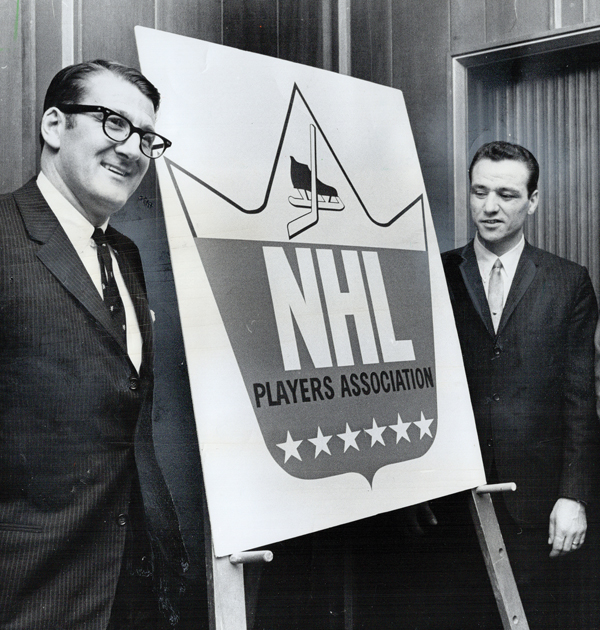 |
NHLPA Executive Director Alan Eagleson (left) and the Toronto Maple Leafs’ Norm Ullman display the union’s crest in 1968.
Photo by: GETTY IMAGES
|
While the NHL is celebrating its 100th anniversary, the NHL Players’ Association turns 60 next month.
The formation of the NHLPA was announced Feb. 12, 1957, but the players’ union has not been in existence for 60 years consecutively. The first iteration of the NHLPA dissolved about a year after it was launched, after the players who organized it came under intense pressure from owners.
The story of the NHLPA is full of that kind of drama and turmoil, enough that it’s been the subject of at least three books and a movie. The players won great victories and suffered big losses.
Although the leadership of the union changed frequently, it was almost always run by tough guys with big personalities, including a power broker who stood up to the Soviets and a star player who risked everything.
Ted Lindsay
1957-1959
He was known as “Terrible Ted” Lindsay as left wing on the Detroit Red Wings’ “Production Line,” which also included Gordie Howe and won four Stanley Cups.
He was only 5-foot-8 but earned his nickname from his ferocious style of play, and the NHL had to pass rules against kneeing and elbowing opponents because of Lindsay. He has said he hated every one of his opponents when he was competing against them on the ice.
However, it was Lindsay who started meeting in 1956 with Nelson Lewis and Milton Mound, two lawyers in New York who had secured some gains for MLB players, about getting some rights for hockey players. And it was Lindsay who got players from opposing teams to meet and form the NHLPA, no easy task.
“Back in the six-team league, we, as players, never spoke to each other on the other team,” Lindsay said in a video filmed by the NHLPA a few years ago. “Now, to form a players association, when you don’t speak to each other, is pretty difficult.”
NHL players had tried to organize at least two times before Lindsay’s effort, according to the book “Net Worth,” by David Cruise and Alison Griffiths, which was later made into a film that aired on Canadian television. But owners quickly snuffed out efforts by the players to organize a union in 1925 and to start a leaguewide pension plan in 1947.
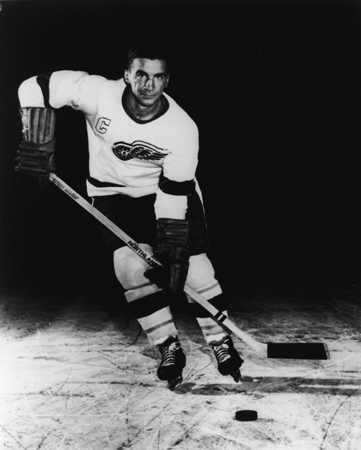 |
Ted Lindsay got players from opposing teams to meet and form the union.
Photo by: GETTY IMAGES
|
Lindsay’s meeting with lawyers in 1956 led to a secret meeting between himself and players from other teams.
As Lindsay recalled in the NHLPA video, the players at his secret meeting included Hall of Fame defenseman Doug Harvey of the Montreal Canadiens, Fernie Flaman of the Boston Bruins, Jimmy Thomson of the Toronto Maple Leafs and Gus Mortson from the Chicago Blackhawks. “We were all there,” Lindsay said, adding that they passed around a hat. “And we had to put $100 in, because we had to pay the lawyers in New York.”
They agreed to form the NHLPA as an association to stick up for the players’ rights.
“So all the fellas said, ‘Now who is going to be the president?’” Lindsay said in the interview, chuckling. “And they all said, ‘It’s Ted’s idea, we’ll make Ted the president,’ knowing darn well when we got back to our home bases on Tuesday morning for practice, somebody was gonna get hung. Well, I knew darn well when I got back to Olympia [arena], the Red Wings wouldn’t be getting dressed for practice.’”
According to “Net Worth,” the general manager of the Red Wings, Jack Adams, on learning of the formation of the players association went to every player on the team and said, “Are you for this? Are you for this?” Only Lindsay would look him in the eye.
In the ensuing months, details of Lindsay’s salary, including a false report that he was making more money than Howe, were leaked to the press. Leaders of the NHLPA were traded to other teams.
Adams broke up the Production Line, trading Lindsay to the Blackhawks in July 1957. In October, the fledgling NHLPA filed an antitrust lawsuit against the NHL, alleging it was a monopoly. In November, the Red Wings withdrew their support for the NHLPA.
Fight The Good Fight:
A History Of The NHLPA
1956
■ A group of NHL players, led by Detroit star Ted Lindsay, meet at the All-Star Game in Montreal and discuss forming a players’ association.
1957
■ The first players’ union is formed by the Red Wings’ Lindsay and the Montreal Canadiens’ Doug Harvey.
1967
■ The National Hockey League Players’ Association is established with Canadian attorney Alan Eagleson as executive director and former NHL player Bob Pulford as president.
1991
■ A series of newspaper stories begins running that details years of corruption within the NHLPA, forcing Eagleson to resign. He is indicted on 34 charges that included racketeering, embezzlement, fraud and obstruction of justice. He pleads guilty in 1998 to multiple counts of fraud for misusing union money, agrees to pay a U.S. fine of about $700,000 and serves six months at the Mimico Correctional Centre in Toronto.
1992
■ On New Year’s Day, agent Bob Goodenow replaces Eagleson as the union’s executive director. In April, the league experiences its first work stoppage when the players vote to strike by a count of 560-4. Play resumes 11 days later, after 30 regular-season games are lost.
1994
■ The league’s first lockout begins Oct. 1 and lasts more than three months. By the end, 468 games are lost. Teams go on to play a 48-game schedule.
1997
■ The CBA is extended through September 2004.
1998
■ The league sends a memo to teams asking each to set aside $10 million for the creation of a lockout fund.
2004
■ In February, former Securities and Exchange Commission Chairman Arthur Levitt, hired by the league to conduct an audit of its books, issues a report that says the league lost $273 million in 2002-03 and that 75 percent of revenue went toward player salaries. He warns the league to replace its economic model, calling it a “treadmill to obscurity.”
■ The CBA expires in September and the players are locked out again. The NHL becomes the first major North American sports league to lose an entire season.
2005
■ A new CBA is ratified in July, and a week later Goodenow leaves as head of the NHLPA. He is succeeded by the union’s senior director of business affairs and licensing, Ted Saskin. The new CBA includes a $39 million salary cap and limits an individual player’s total compensation to a maximum of $7.8 million.
2007
■ NHLPA player representatives vote to fire Saskin after reviewing a report from an outside attorney about allegations that he read players’ personal emails. Attorney Paul Kelly is named as his replacement.
2009
■ After Kelly has spent just 22 months in charge of the players’ union, the NHLPA executive committee votes to remove him as executive director.
2010
■ Donald Fehr, Major League Baseball Players Association executive director from 1985 to 2009, is tapped as Kelly’s replacement.
2012
■ The collective-bargaining agreement expires and players are locked out in September, the fourth NHL work stoppage in 20 years.
2013
■ Clubs begin playing a 48-game season in January after the lockout results in the cancellation of 510 games.
2016
■ The salary cap is set at $73 million with a salary cap floor of $54 million.
Source: SportsBusiness Journal research
By early 1958, there wasn’t much support among players for trying to form an association. Lindsay and the lawyers agreed to settle the lawsuit against the NHL in exchange for a few concessions, including a $7,000 minimum salary, an increase in the players’ playoff pool and payment of moving expenses for a traded player.
Nevertheless, today many within the NHL player ranks view Lindsay as the true founder of their union. In 2010, the NHLPA renamed its highest award — as voted on by the player membership — the Ted Lindsay Award.
But it took almost 10 years for the NHLPA to form again.
Alan Eagleson
1967-1991
For many hockey fans old enough to remember, their most vivid recollection of Alan Eagleson is his marching across the ice in a suit, holding up a fist and his middle finger.
The year was 1972, and Eagleson was protesting the Soviet goal judge’s refusal to light the goal lamp after Canada scored in the final game of the Summit Series. Eagleson was the organizer of that eight-game series, which Canada won.
He also was a director of Hockey Canada; the founding partner in Eagleson Ungerman, a law firm that represented as many as 150 NHL players; and executive director of the NHL Players’ Association.
“Oh, my God, he had so many conflicts of interest, it would spin your head,” said Russ Conway, author and journalist, who wrote a series of articles and a book that led to an investigation of Eagleson by U.S. and Canadian law enforcement authorities. “I called it the great hat trick. I sat in his office and listened to his receptionist answer the phone, and she’d answer it like this, ‘Eagleson Ungerman, no I mean Players’ Association, no I mean Hockey Canada,’ I remember. We both laughed about it.”
In 1967, the NHL players tried to organize a union again, and this time the league’s owners agreed to recognize it as a legal entity. Eagleson, who was the agent for then-phenom Bobby Orr, was named the NHLPA’s first executive director.
During his 25-year tenure as executive director, Eagleson negotiated four collective-bargaining agreements without a lockout or a strike. The first one was in 1976, followed by successor agreements in 1981, ’84 and ’88.
Compared with most sports union leaders, past and present, Eagleson had a warm relationship with management. Eagleson had especially close friendships with John Ziegler Jr., former president of the NHL, and Bill Wirtz, president and owner of the Blackhawks.
In his book “Power Plays,” Gil Stein, the NHL’s former general counsel, president and CEO, described in detail how Ziegler and Eagleson would negotiate a collective-bargaining agreement over a series of days in a hotel in which owner and player representatives were present in different rooms.
“A charade of sorts would take place,” Stein wrote. Zeigler and Eagleson essentially would pretend to fight in front of their constituencies over a deal when, in fact, the principle points of the agreement were agreed upon in advance by the two friends.
At the end, when a deal was agreed to, the owners would host a dinner party for the owners, the players and the players’ wives.
“Everyone who was there could attest to how difficult the negotiations had been, and how fruitful had been the hard-fought gains for each side,” Stein wrote. “To us, it appeared the players never suspected the scenario may have been carefully scripted in advance.”
Stein wrote that players “fared well” under Eagleson’s leadership, although he noted that some of Eagleson’s critics felt differently.
In 1989, two of those critics, NHL agents Ritch Winter and Ron Salcer, with the help of Ed Garvey, former executive director of the NFL Players Association and a labor lawyer, held a summer meeting with players to air their concerns about Eagleson. The result was that the union hired Bob Goodenow, an NHL agent, as executive director.
Under the terms of his hiring, Goodenow would serve as deputy executive director, under Eagleson, and would become executive director in 1992.
Meanwhile, Conway, who had been covering the NHL and the NHLPA for the Lawrence (Mass.) Eagle-Tribune, began investigating Eagleson’s business interests and actions, including improprieties involving the players’ pension and disability insurance, in a series of articles called “Cracking the Ice,” which began running in the fall of 1991.
It didn’t take long for federal law enforcement to take notice of Conway’s work and the allegations.
The Eagle-Tribune stories “had a lot to do with initiating the investigation,” said Paul Kelly, who in 1991 was an assistant U.S. attorney in Boston. “Obviously, we as federal prosecutors and the FBI had the ability to issue grand jury subpoenas, search warrants, travel and obtain evidence from various international locations. We had access that Russ didn’t have. He kind of gave us a road map of various areas we should be looking in. And we developed enough evidence to indict Eagleson.”
In October 1994, Kelly’s then boss, U.S. Attorney Donald Stern, secured an indictment of Eagleson on more than 30 counts involving various alleged violations of the federal Racketeer Influenced and Corrupt Organizations law.
“The heart of today’s indictments is that Mr. Eagleson breached his fiduciary responsibilities and obligations in the duty of providing honest services that he owed to members of the union,” Stern said in announcing the indictments, according to Conway’s book, “Game Misconduct: Alan Eagleson and the Corruption of Hockey.”
It took almost four more years of discussions and negotiations between U.S. and Canadian authorities and Eagleson to strike a deal in which Eagleson pleaded guilty and went to jail in Canada, where he served six months. Eagleson pleaded guilty in U.S. federal court to three counts of fraud and paid a $700,000 fine on Jan. 6, 1998, and pleaded guilty the next day to three more counts of fraud in a Canadian court.
Meanwhile, Goodenow was in control of the players association and it was a different union, entirely.
Bob Goodenow
1992-2005
Within six months of Goodenow taking the reins of the NHLPA, the cozy relationship it enjoyed with the league for more than two decades was turned upside down.
Taking over in ’92, Goodenow led the players on a strike right before the playoffs in 1992 — a strike that the players won. Those who know the NHL’s recent history may be surprised to learn that player salaries were not the reason for the strike in 1992.
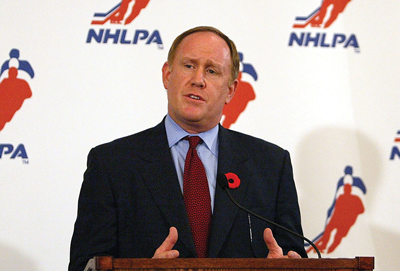 |
Bob Goodenow led the union during the lockout that forced the 2004-05 season to be canceled.
Photo by: GETTY IMAGES
|
Instead, the NHLPA was focused on getting the players the rights to their names and likenesses for licensing purposes, which, at that time, were held by the league. “It was called the ‘Trading Card Strike,’” Goodenow said.
NHL players, who had never previously waged a strike or been locked out, voted 560 to 4 in favor of striking. It began April 1 and lasted 10 days.
“If we weren’t able to get all the rights and controls over the likenesses of the players, we wouldn’t have been able to have the licensing revenues that gave us the strength to do all the things that we did,” Goodenow said. The players won other rights, as well, including in free agency and neutral arbitration.
That strike was also widely seen as the reason that Ziegler resigned as president of the NHL.
Ziegler announced on June 11, 1992, that he would step down Sept. 30. Gary Bettman was brought in as the NHL’s first commissioner on Feb. 1, 1993. Bettman had been general counsel of the NBA.
Although player salaries were not the main issue in the ’92 strike, that changed within a few years, as player pay began increasing because of salary disclosure that Goodenow put in place. “Salary disclosure was one of the first things I did on the job,” he said. “There were players who didn’t want it, but they quickly discovered what a great tool it was.”
In 1994, the league began making labor proposals to the NHLPA that included taxes and other mechanisms meant to control salary escalation.
“They didn’t want to use the words ‘salary cap,’ because they knew that was a phrase the players would recoil from,” Goodenow said. “So they said, we will negotiate, we allow teams to spend, but we’ll just put taxes on it. And the net effect was the tax rate was so onerous it was just like a salary cap.”
The players rejected those proposals, causing the NHL’s first lockout. It lasted from Oct. 1, 1994, to Jan. 11, 1995. The NHL played a 48-game season instead of an 84-game season in 1995.
In the end, the players and owners agreed to a collective-bargaining agreement that did not include a cap on veterans’ salaries but did include some controls on entry-level players.
“There were controls on salary and signing bonus, but there were unlimited performance bonuses,” Goodenow said. Those bonuses allowed standout rookies, who performed at a high level, such as Eric Lindros, to be rewarded when they played like an NHL star early in their careers.
The NHL and NHLPA enjoyed labor peace for about 10 years. Before the expiration of that six-year CBA that ended the 1994-95 lockout, the owners approached the players with an offer.
“They came to us and extended it for four years,” Goodenow said. “They liked the deal and they wanted the deal extended and we agreed with it. We made some minor changes, but the essence of the contract was the same.”
But a few years before the expiration of the extended CBA in 2004, the NHL and its owners made it clear that the CBA was no longer working for them and that they needed a hard salary cap. The league hired former Security and Exchange Commission Chairman Arthur Levitt to write a report on NHL finances. He found that the league was losing $273 million overall and put the blame at the feet of escalating player salaries.
The NHLPA rejected many of the findings of the Levitt report, saying the union had no input in the report and noting that Levitt was paid $1 million to write it.
Goodenow began preparing players for another lockout and warned them that this time, they might not just lose half a season.
“I forecasted the lockout and I forecasted the loss of the season and I told them it would not be until the second season that there would be a negotiation,” Goodenow said.
The lockout began Sept. 16, 2004, and Bettman announced the cancellation of the 2004-05 season on Feb. 16, 2005.
At a certain point in the negotiations, Bettman and Goodenow gave way to the NHL’s Bill Daly and Goodenow’s trusted deputy, Ted Saskin. After that, as SportsBusiness Journal reported at the time, a group of players and Saskin, then head of licensing for the NHLPA, began negotiating a deal that included a hard salary cap.
Goodenow said what the players agreed to was four salary caps.
“They brought in a cap, a hard cap,” he said. “An individual player cap — a player can’t get more than 20 percent of the team salary cap. There was a rookie cap, there was a player cap, there was a team cap and a league cap — and escrow. And it was everything I warned the players not to do — for a lot of reasons. But for various reasons and pressures, they felt the need to do it and they did it and now they’re living with it.”
Goodenow stated that he resigned on July 29, 2005, a week after the deal was signed, and he hasn’t talked publicly about what happened for more than 10 years. SportsBusiness Journal reported and an independent investigation later found that Goodenow was fired by a small group of players on the executive committee. That violated the union’s constitution because the executive director can be fired only by a majority vote of all the team player representatives.
Goodenow would not talk about his departure, but when pressed, he did say he wasn’t the person who negotiated the current deal. “I wasn’t the person to negotiate a new CBA with four salary caps, because I didn’t believe in it,” he said.
Asked why the players agreed to the caps, Goodenow said to ask them. “I think they lost their way, that’s the only way I could describe it,” he added. “They lost their way for various reasons.”
More than 10 years later, Goodenow said he is happy and at peace. But he does wish it had turned out differently for the players.
“I feel badly for the players,” he said. “I wish the players had listened and held to their principles.”
Ted Saskin
2005-2007
Saskin was named to replace Goodenow as executive director in the summer of 2005, but that started another fight, this time within the ranks of the player membership.
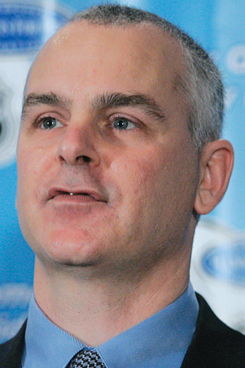 |
SASKIN
|
A group of players led by Hall of Fame defenseman Chris Chelios alleged that both Goodenow was fired and Saskin was hired without the majority vote of the membership and that both actions violated the NHLPA constitution. The group led by Chelios, known somewhat derisively as “the dissidents,” fought with players who said the union should just “move on” under Saskin.
“In the beginning it was tough,” Chelios said of the fight to remove Saskin, adding, “It wasn’t just me.” Chelios said one of the reasons he worked so hard on the effort is he was one of the few veterans who was an NHLPA member under Eagleson.
“Bob had our best interests at heart,” Chelios said. “How they fired him made it easy for him to walk away. Personally, I wished he didn’t do that, because only a few guys wanted him fired.”
In the end, an independent investigator hired by the union found that Goodenow was fired without proper authority, but did not come to a conclusion about whether Saskin’s hiring met the union’s constitutional standings. However, the investigation revealed that Saskin had been surreptitiously reading NHL players’ emails sent through their NHLPA.com accounts.
Saskin was fired by the players in May 2007 over the email scandal. This time, “all the teams voted and it was unanimous,” Chelios said. “The only reason it took so long is Ted did a great job of dividing the players. He knew by looking at the emails who was on his side and who wasn’t.”
Paul Kelly
2007-2009
After Saskin’s firing, players turned to Chicago-based search firm Reilly & Partners to look for a new executive director.
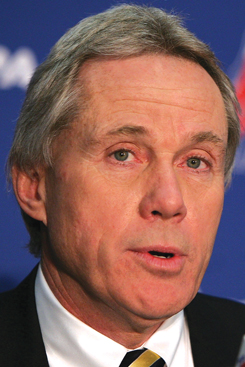 |
KELLY
|
Because of his work in helping to prosecute Eagleson, Kelly, who in 2007 was working as a criminal defense attorney in private practice, received a call from the search firm.
Kelly was hired as executive director in October 2007, but today says his tenure was doomed from the start. That’s because the players, smarting from their experience with Saskin, had put in a new governance structure that took power away from the executive director and gave it to an advisory committee, a general counsel and an ombudsman.
“The group of players led by Chris Chelios who tried to get Saskin out of the position had a lot of difficulty doing that,” Kelly said. “So they wanted to put in place a structure that effectively gave them the ability to assassinate the executive director any time they wanted for any reason.”
Kelly said he could not talk about the specifics of his leaving the NHLPA, but he was dismissed in August 2009, less than two years after he took the job.
Don Fehr
2010-2017
After firing three executive directors in fewer than five years, the players this time turned not to a search firm, but to Don Fehr, who had recently retired as longtime executive director of the MLB Players Association, to assist them with finding a new leader. Fehr developed a reputation as the strongest player leader in sports after he fought off a salary cap and won a battle with MLB team owners during the 1994-95 baseball strike.
| Season |
Average compensation |
| 1990-91 |
$271,000 |
| 1991-92 |
$368,000 |
| 1992-93 |
$467,000 |
| 1993-94 |
$572,161 |
| 1994-95 |
$733,000 |
| 1995-96 |
$892,000 |
| 1996-97 |
$984,500 |
| 1997-98 |
$1,167,713 |
| 1998-99 |
$1,288,974 |
| 1999-00 |
$1,356,380 |
| 2000-01 |
$1,434,884 |
| 2001-02 |
$1,642,590 |
| 2002-03 |
$1,790,209 |
| 2003-04 |
$1,830,126 |
| 2004-05 |
Lockout |
| 2005-06 |
$1,458,002 |
| 2006-07 |
$1,708,607 |
| 2007-08 |
$1,906,793 |
| 2008-09 |
$2,196,796 |
| 2009-10 |
$2,254,044 |
| 2010-11 |
$2,284,753 |
| 2011-12 |
$2,452,644 |
| 2012-13 |
$2,478,172 |
| 2013-14 |
$2,581,827 |
| 2014-15 |
$2,803,043 |
| 2015-16 |
$2,881,758 |
Source: NHLPA
Fehr came to advise the NHLPA, but he ended up staying on as executive director at the request of the players.
“I was asked to give them advice on how to restructure the organization, how to formulate it, to educate the players on what a union is and how it works,” Fehr said. “And then I was asked if I would agree to work with them on a search committee, which I did with five players.”
As SportsBusiness Journal reported, although Fehr came in with the intention of helping them to find a new executive director, somewhere in that process the players told him they wanted him to lead the union. At that point, the NHL CBA that had been negotiated during the 2004-05 lockout was close to expiring.
“They asked me to take it up on the theory that they had a negotiation coming right up and to see if I could help them through that period,” Fehr said. “I had become impressed with the players, their dedication, their desire for change. … And I decided I wanted to give it a go.”
In December 2010, NHL players voted overwhelmingly to elect Fehr as executive director.
On Sept. 15, 2012, the NHL again locked out the players, until Jan. 6, 2013, when they agreed to a new CBA that lowered the percentage of hockey-related revenue that players received from 57 percent to 50 percent.
Fehr, who had served as MLBPA executive director from 1985 to 2009, said he knew Eagleson, but did not know him well.
Asked whether the NHLPA was a legitimate union under Eagleson, Fehr said, “I am not going to buy into the word ‘legitimate,’ because that has connotations of whether or not you have rights under the law to bargain. But I will say it did not seem to me it was an effective union, in terms of representing the best interests of the players.”
Fehr did know and was impressed by Goodenow, especially his leadership during the 1992 strike, when he had first taken over the union.
“You can argue back and forth about what happened in that first negotiation of Bob’s and whether it was easy and low-hanging fruit or whether it was tough or should it have been handled differently,” Fehr said. “But the fact is the primary focus of that first negotiation was and had to be establishing the players as a force the owners had to reckon with. It was about credibility.
“And that was established and that was no mean accomplishment. Without that credibility, you have nothing.”
Regarding the stretch of turnover at the top of the union, Fehr pointed out that executive director is a political position. Union executive directors serve at the pleasure of the players.
“But understand what the players’ right is,” he said. “They have a right to have a leader of their choosing, an executive director of their choosing for good reasons, for bad reasons or for no reasons at all.”
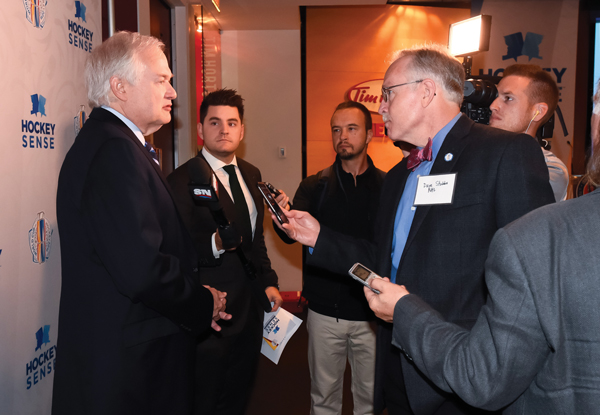 |
Current executive director Don Fehr previously led the MLB Players Association.
Photo by: GETTY IMAGES
|









